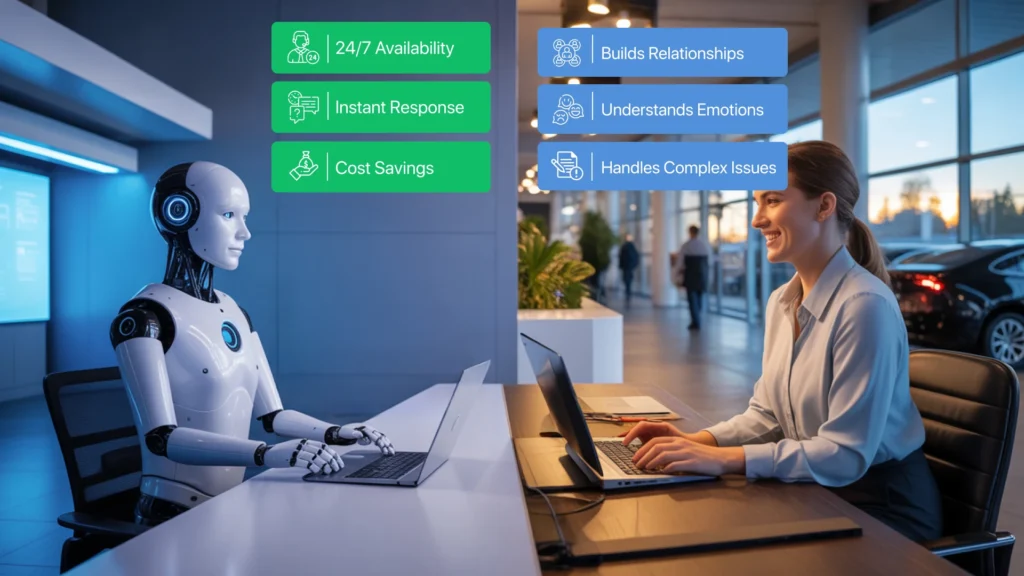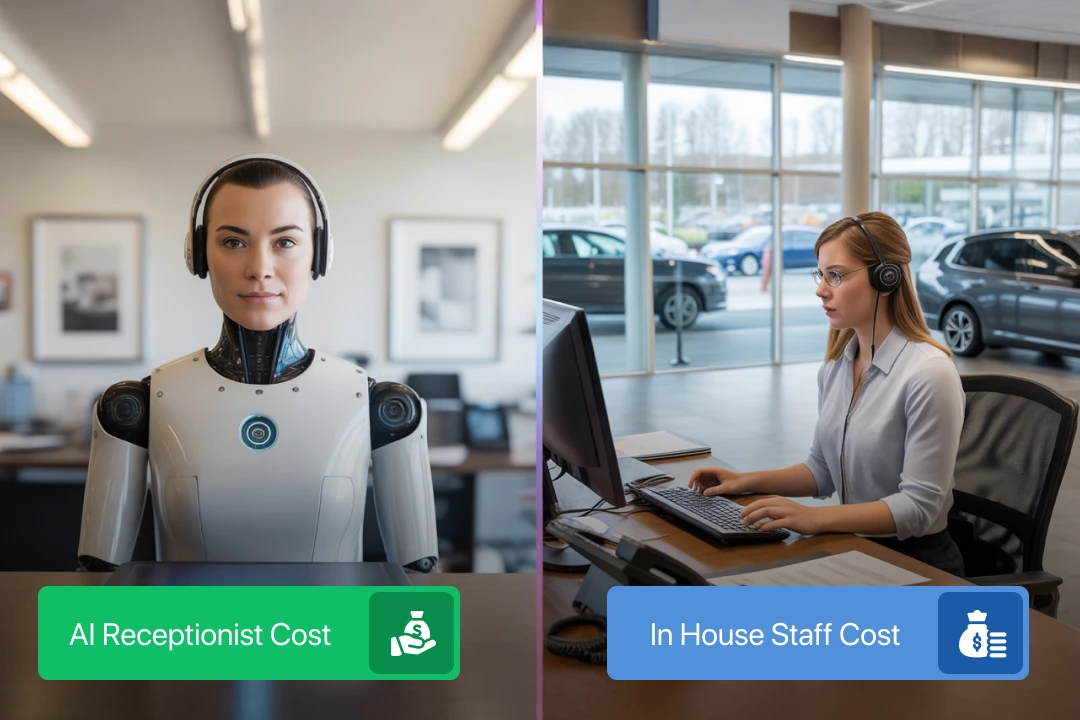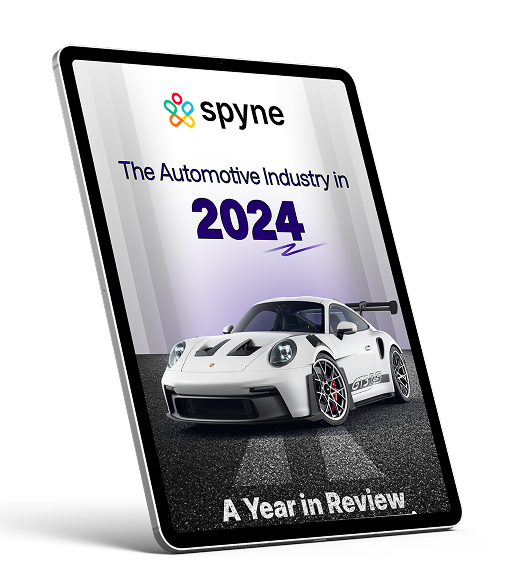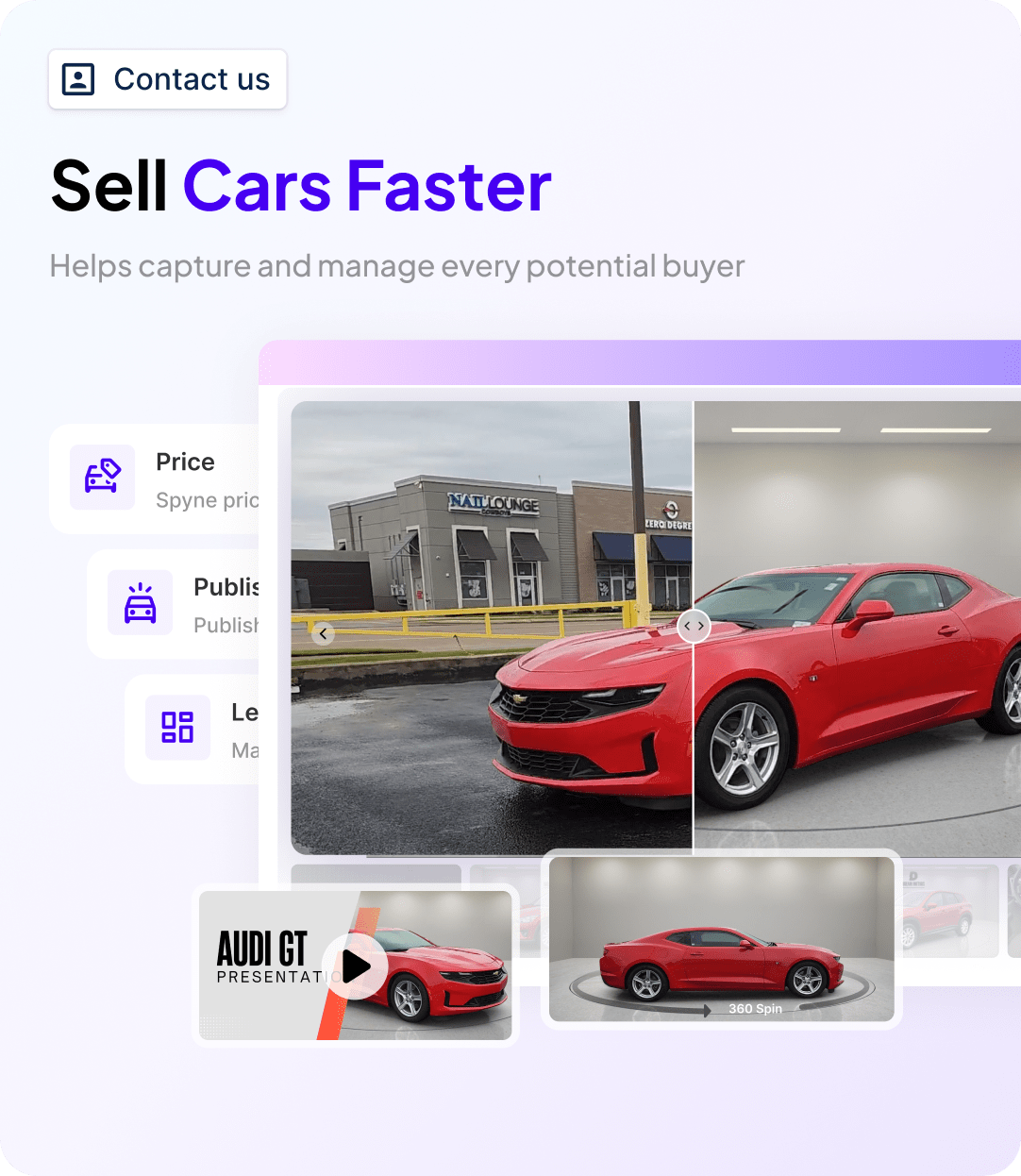Looking for a receptionist for your business? But first, consider the costs of hiring one. Modern businesses want the best option, which is productivity, but also affordable at the same time. With this intention in mind, they consider the AI receptionist cost vs in house staff cost to make the right decision. Human receptionists require salaries and additional benefits, which are comparatively expensive than an AI receptionist that requires only initial setup and monthly maintenance.
In this blog, we talk about the pricing structure of virtual receptionists as well as human staff. Also, it includes the difference between the two and how AI receptionists help dealerships earn back their invested capital.
Understanding AI Receptionist Cost vs In-House Staff Cost
AI receptionists provide a cost-effective solution for businesses compared to in-house receptionists. The AI agents require an initial setup investment, whereas human receptionists require employment costs. These include salaries, additional benefits, and training requirements. Here is a comparison of AI receptionist cost vs in house staff cost for more clarity into pricing structure.
Costs of an AI receptionist
- Setup Costs: AI virtual receptionist cost includes the initial setup and implementation charges. Therefore, this investment can range between $1,000 – $5,000, which includes setup and integration according to your business requirements.
- Monthly Plans: The monthly service plans for AI employees can range from $25 to $3,000. The basic services are provided within a range of $30 to $200, whereas the advanced AI features are provided within the range of $100 to $1,500 per month for an AI receptionist.
- Charges for Extra Usage: If the virtual receptionist services used by the business exceed the plan limit, then they are charged additional fees for the extra usage. These charges range between $0.80 – $2.50 per minute.
- Service Level Pricing Structure: Businesses need to choose the facility of an AI receptionist according to their needs and requirements. Basic plans may be the right fit for one business, while an advanced plan for another.
| Service Level | Best For | Monthly Plan | AI Receptionist’s Features |
| Basic Level | Small Businesses | $149-$279 | Only works in business hours, offers a single phone line, supports basic system integrations, as well as analytics |
| Advanced Level | Growing Businesses | $299-$1,000 | Provides 24/7 communication support, supports multiple phone lines, advanced integrations, and provides detailed AI call analytics |
| Enterprise Level | Large Businesses | $1,000-$3,000 | Smart call handling features, unlimited minutes for calls, support integrations, and offers after-hours support |
Costs of In-House Staff
- Salaries and Additional Benefits: The annual base salaries of an in-house receptionist range between $37,000 – $38,000. Additionally, they get extra benefits like health insurance, overtime charges, paid leaves, retirement plans, etc.
- Training Costs: Human receptionists are provided with proper training and live workshop sessions to improve their communication and organizational skills. Therefore, the training costs for in-house staff range between $4,000 – $7,000.
- Workspace Investments: The front desk receptionist needs a dedicated workspace and furniture in the office area. Additionally, they need computers, phones, and other business-related equipment for a proper reception setup. However, this investment ranges between $5000 – $20,000.
What is the Difference Between an AI Receptionist and a Human Receptionist?
AI receptionists and human receptionists offer several benefits. Since we have discussed about AI receptionist cost vs in house staff cost, now comes the difference between the two. An AI assistant offers a cost-effective solution, handles calls, as well as improves efficiency. The human receptionists provide a personal touch in business processes and handle complex issues. Here is the difference between an AI receptionist vs human receptionist.
| Features | AI Receptionist | Human Receptionist |
| Setup and Training Costs | Requires initial setup and maintenance costs | Costs include base salary, additional benefits, workspace, training, and business equipment |
| Consistency in Responses | Delivers responses with the same consistency according to business tone | Responses may vary depending on the individual representative and mood |
| Problem Solving | Programmed to solve limited problems and issues | Capable of handling complex problems and processes, including financing and deal closure |
| Call Handling Capabilities | An AI receptionist can handle high volumes of calls, provide features like call diversion, routing, etc, without charging additional fees | Cannot handle numerous calls, which may lead to missed opportunities |
| Integration | Supports seamless integration with existing systems to provide visibility and data-driven insights | Human receptionists rely on manual processes for gaining reports and analytics, and decision-making |
| Availability | Provides 24/7 support, including after hours answering service, weekends, and holidays | Only works during fixed business hours |
| Personal Touch | Lacks a deep understanding of customer emotions and provides basic personalization in communication based on customer preferences | Deeply understands customer emotions and preferences to offer extreme personalization, which helps to build long-lasting relationships |
| Scalability | Provides scalability to support your business growth and can store and manage high volumes of customer interactions without extra charges | Requires extra staff for handling increased call volumes, which leads to more expenses for salaries and workspace |
| Chances of Errors | Reduces the chances of errors and provides accurate responses and insights | Humans have the potential to make errors in business processes, like data entry |
| Workflow Management | Automates routine business tasks like scheduling appointments, answering phone calls, capturing high-intent leads, and driving efficient fixed operations | Performs tasks like setting appointments or sending follow-ups manually, leading to slower responses and reduced efficiency |

How Does AI Receptionist Cost vs In House Staff Cost Impact ROI and Business Growth?
Hiring a human receptionist is proven to be expensive compared to AI receptionists. Virtual AI sales assistants provide 24/7 availability and automation of routine workflow, hence improving operational efficiency and driving productivity. AI enabled many businesses and BDC companies to earn their investments made on virtual receptionists back. They experienced customer satisfaction while saving 50% lower costs on each call. With the advancements of AI in customer service, businesses are able to increase their revenue by 19.6%. The virtual receptionists do not need an allotted workspace because they work completely on technology.
Customers prefer instant responses; thus, businesses using traditional voicemail and calling systems are left behind by businesses using AI to capture leads. In the case of voicemail, 60% of customers leave the call without dropping a message, whereas AI helps businesses to capture 85% of leads efficiently across various channels. A study shows that conversion rates can be increased when customers are responded to within a few minutes of initial inquiry. AI provides quick and accurate responses within 60 seconds, enhancing the customer experience, converting leads, and boosting sales performance. Hence, this helps to improve the customer ratings by about 20.5%, helping businesses to gain loyalty and foster long-term customer relationships.
Why Should You Choose Spyne When Comparing AI Receptionist Cost vs In House Staff Cost?
Spyne provides AI solutions for the automation of your dealership workflow. We are built specially for automotive businesses and help them drive efficiency and productivity. When it comes to the comparison of AI receptionist cost vs in house staff cost, Spyne’s Conversational AI serves as an affordable and scalable option for dealerships seeking for virtual receptionist.
1. Streamline Repetitive Tasks
Spyne takes over your dealership’s repetitive tasks through an automated lead follow up system for car dealerships. It helps you schedule appointments automatically, sends personalized follow-ups to customers, as well as answers incoming phone calls to answer basic questions.
2. Ensures Real-time Call Tracking
We are capable of handling high volumes of calls, managing them, and tracking customer interactions to gain insights into their preferences. We offer automotive call monitoring software in order to track records, analyze customer interactions, and gain real-time call transcriptions to improve call quality.
3. Scalable and Cost-Effective Solution
Scaling with the growth of your dealership is very crucial. Spyne’s AI can store and manage contacts as your customer base increases. It is an affordable solution for dealerships of all sizes, whether small or large.
4. Provides Consistent Customer Service
We ensure no gaps in your customer service. Our AI receptionist for car dealerships provides 24/7 communication support to answer calls, book appointments, and provide quick responses to customers. Our AI delivers enhanced personalized and consistent responses based on your brand tone and customer preferences.
5. Prioritizes Hot Leads For Faster Conversion
Spyne’s AI goes beyond capturing and responding to leads. Our AI lead scoring for car dealerships captures leads, identifies their intent, and prioritizes them according to their interest. This enables you to focus on hot leads for faster deal closure, hence increasing the conversion rates.
6. Smooth Integration with Existing Systems
Spyne centralizes all your data in a single dashboard by integrating automotive CRM with your dealership’s existing systems. This gathers all the data from various systems and communication platforms, hence keeping all the departments on the same page.
Conclusion
AI is changing the way receptionists operate their front desk processes. Whether hiring a human receptionist or adopting an AI receptionist, considering the receptionist pricing structure saves you from harming your bank. A detailed comparison between AI receptionist cost vs in house staff cost gives you clarity on what to pick. AI helps you reduce your business costs to a significant extent by avoiding the need for workspace, training, or additional equipment. Despite these benefits, they lack a deep understanding of human emotions and are unable to handle complex situations, something at which humans receptionist excels.
Spyne is an affordable yet scalable solution for dealerships looking for the implementation of an AI receptionist for their everyday tasks. We help you with completing the tasks automatically, managing your calls, and driving efficiency. So, why wait for? Book a free demo with Spyne today!














